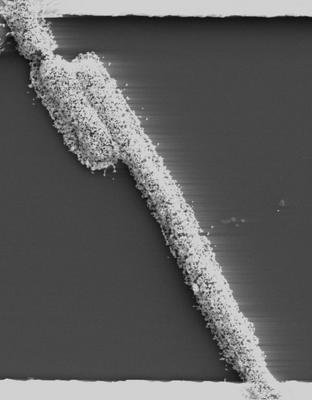Live bacteria used as electrical sensor
Blurring the line between alive and not-alive...Live, gold-dusted bacteria used in bioelectronic device
Office of University Communications
University of Nebraska-Lincoln
Working with Vikas Berry, a doctoral student in his laboratory, Ravi Ravi Saraf created what he said he thinks is the first use of a microorganism to make a bioelectronic device with a live microorganism.
Saraf and Berry deposited bacteria (Bacillus cereus) on a standard silicon chip inlaid with gold electrodes. After the bacteria formed bridges between the electrodes, Saraf and Berry deposited gold nanoparticles measuring about 30 nanometers (30 billionths of a meter) on the bacteria and introduced an electric current.
"On the bacteria's surface, there are these filaments that grab the nanoparticles," said Saraf, who came to UNL last year from Virginia Tech. "When the humidity increases, the bacteria swells because it absorbs moisture, and it contracts when the humidity goes down. When it swells or contracts, it increases or decreases the distance between the nanoparticles."

"That's great, but what really excites me is 'What's next?'" he said. "This work clearly shows that you can make nanodevices on live cells. Now, can we take the next step and have the live cell drive the nanodevice?"
Saraf said his idea is that microorganisms could be used to open and close electronic circuits, and maybe even power them.
University of Nebraska press release...



0 Comments:
Post a Comment
<< Home